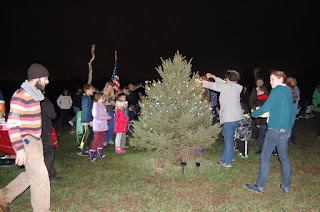As I’m writing this blog post, rain and ice has been falling since yesterday. The cold
temperatures, rain, and ice may make you want to stay inside, bundled nice and
warm, but here at TLC, we believe “the warmth is in the walk!” Despite the
16-degree weather last Saturday, a room full of winter-ready, excited
participants joined me and expert TLC Naturalist, Gary, to learn all about the
Mammals of Southeastern Pennsylvania.
The program started out indoors at TLC’s Walnut Hill
Headquarters, where Gary laid out fascinating pelts, skulls, and antlers of
mammals from our area. Gary began the program by talking about what makes a mammal
a mammal: being warm-blooded, having hair, birthing live babies (except for
Platypuses, which lay eggs, of course), and having mammary glands. He touched
on the apex predators which historically lived here, including the Eastern
Timberwolf, the Bobcat, and the Black Bear, and how in their absence, the
ecosystem has changed completely. Naturally, this brought us to a discussion about
the White-tailed Deer, whose populations have exploded in recent years because
of the lack of the apex predators. This explosion in Deer has given the
invasive plants in our area an advantage; the White-tailed Deer have evolved to
choose the native plants as their food source leaving invasives like Autumn-olive,
Multiflora rose, and Mile-a-Minute completely untouched.
 |
| The photo on the left shows Gary holding the pelt of a Nutria, an invasive species in North America which is part of the rodent family. On the right, he is explaining how mammal's skulls have evolved to eat meat, vegetation, or both. |
Then, we started to talk about other families of mammals:
Canines (Coyotes, Eastern Gray Fox, and Red Fox), the Felines (Bobcats), the
Weasels (Minks, Otters, Martins) and more.
Gary discussed the different senses these mammals use—how Canines with
their long noses utilize their sense of smell, and Felines have short noses,
but big eyes which allow them to hunt primarily by sight. He pulled out a
Coyote skull, and showed us how these carnivores have teeth built for tearing
and slicing meat as opposed to the teeth of herbivorous deer, which primarily
have molars for grinding vegetation. As omnivores, human teeth fall somewhere
in-between, with both incisors for tearing and molars for grinding.
At that point, we grabbed our Tracks & Scat field
guides, bundled up, and headed outside to search for evidence of mammals in the
area. Since we had already learned most mammals are nocturnal, we knew
searching for evidence is the best way to understand what is living in our
area. Just steps away, right beneath the Chandler Mill Bridge we were able to
find a large amount of frozen tracks in the mud. We immediately spotted some
tiny tracks leading up to the creek, which we keyed out to be a gray squirrel.
We moved further along the creek, and found raccoon tracks, more squirrel
tracks, domestic dog tracks, and what we believe were mink tracks!
 |
| The tracks on the left were left by a Raccoon, the photo on the right shows various different animal tracks. |
TLC offers a host of outdoor education programs all year
round at Bucktoe Creek Preserve. Up next we have Wildlife in Winter Part II: Adaptations with Naturalist Holly
Merker. This program will be held on Saturday, February 20th from
1:00-2:30. Learn how wildlife in our area survive the extreme winter weather by
using different types of adaptations, such as camouflage. Check out all of our
upcoming programs here.






















